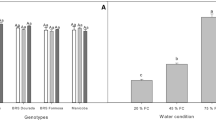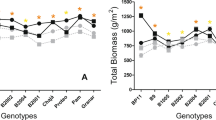Abstract
The development of cassava (Manihot esculenta Crantz) with a high yield under water-deficit conditions is one of the goal of the breeding programs. The objective of this study was to evaluate the performance and to select cassava accessions based on drought tolerance indices and productive potential under water stress. Forty-nine accessions were evaluated for five agronomic traits (plant height—PH, root yield—RoY, shoot yield—ShY, harvest index—HI; and dry matter content of roots—DMC) under full irrigation conditions and drought stress (DS). The accessions were selected based on: (i) high yield under drought conditions (HY-DS) and (ii) high drought tolerance (Dr-To) based on six different indices. Overall, water stress dramatically reduced the traits’ means (RoY—72.98%, ShY—54.95%, DMC—26.15%, HI—31.05%, and PH—32.95%). Low coincidence among the top ten accessions was identified based on HY-DS and Dr-To criteria. Therefore, considering only the most important traits (RoY and ShY), five accessions (BGM0815, BGM0598, 9624-09, BGM0818, and BRS Formosa) presented high HY-DS. In contrast, to Dr-To criterion, eight and nine accessions were selected for high yield of the aerial part (ShY and PH) and roots (RoY and DMC), respectively. The mean productivity, geometric mean productivity, and drought tolerance indices were the most promising to identify genotypes with high agronomic attributes, while drought susceptibility index, susceptibility, and yield stability index were suitable to identify the most drought tolerant accessions. This set of selected accessions can be used in breeding programs aimed at high yield and drought tolerance.






Similar content being viewed by others
References
Adjebeng-Danquah J, Gracen VE, Offei SK, Asante IK, Manu-Aduening J (2016) Genetic variability in storage root bulking of cassava genotypes under irrigation and no irrigation. Agric Food Sec 5:9. doi:10.1186/s40066-016-0055-7
Agili S, Nyende B, Ngamau K, Masinde P (2012) Selection, yield evaluation, drought tolerance indices of orange-flesh sweet potato (Ipomoea batatas Lam) hybrid clone. J Nutr Food Sci 2:138. doi:10.4172/2155-9600.1000138
Aina OO, Dixon AGO, Akinrinde EA (2007) Effect of soil moisture stress on growth and yield of cassava in Nigeria. Pak J Biol Sci 10:3085–3090
Alves AAC, Setter T (2004) Response of cassava leaf area expansion to water deficit: cell proliferation, cell expansion and delayed development. Ann Bot 94:605–613
Ambachew D, Mekbib F, Asfaw A, Beebe SE, Blair MW (2015) Trait associations in common bean genotypes grown under drought stress and field infestation by BSM bean fly. Crop J 3:305–316
Azevedo CF, Resende MDV, Silva FF, Viana JMS, Valente MSF, Resende MFR Jr, Oliveira EJ (2016) New accuracy estimators for genomic selection with application in a cassava (Manihot esculenta) breeding program. Genet Mol Res 15:4. doi:10.4238/gmr.15048838
Bates D, Maechler M, Bolker B, Walker S (2015) Fitting linear mixed-effects models using lme4. J Stat Softw 67:1–48
Bergantin VR, Yamauchi A, Pardales JR Jr, Bolatete DM Jr (2004) Screening cassava genotypes for resistance to water deficit during crop establishment. Philipp J Crop Sci 29:29–39
Bouslama M, Schapaugh WT (1984) Stress tolerance in soybean. Part 1: evaluation of three screening techniques for heat and drought tolerance. Crop Sci 24:933–937
Cabello R, Monneveux P, De Mendiburu F, Bonierbale M (2013) Comparison of yield based drought tolerance indices in improved varieties, genetic stocks and landraces of potato (Solanum tuberosum L.). Euphytica 193:147–156
Cach NT, Lenis JI, Perez JC, Morante N, Calle F, Ceballos H (2006) Inheritance of useful traits in cassava grow in subhumid conditions. Plant Breed 125:177–182
Cattivelli L, Rizza F, Badeck FW, Mazzucotelli E, Mastrangelo AM, Francia E, Marè C, Tondelli A, Stanca AM (2008) Drought tolerance improvement in crop plants: an integrated view from breeding to genomics. Field Crops Res 105:1–14
Chemonges M, Balyejusa EK, Bisikwa J, Osiru DSO (2013) Phenotypic and physiological traits associated with drought tolerant cassava cultivars in Uganda. Afr Crop Sci Conf Proceed 11:463–469
Darkwa K, Ambachew D, Mohammed H, Asfaw A, Blair MW (2016) Evaluation of common bean (Phaseolus vulgaris L.) genotypes for drought stress adaptation in Ethiopia. Crop J 4:367–376
Duque LO, Setter T (2013) Cassava response to water deficit in deep pots: root and shoot growth, ABA, and carbohydrate reserves in stems, leaves and storage roots. Trop Plant Biol 6:199–209
El-Mohsen AAA, El-Shafi MAA, Gheith EMS, Suleiman HS (2015) Using different statistical procedures for evaluating drought tolerance indices of bread wheat genotypes. Adv Agric Biol 4:19–30
El-Sharkawy MA (1993) Drought tolerant cassava for Africa, Asia and Latin America: breeding projects work to stabilize productivity without increasing pressures on limited natural resources. Bioscience 43:441–451
El-Sharkawy MA (2007) Physiological characteristics of cassava tolerance to prolonged drought in the tropics: implications for breeding cultivars adapted to seasonally dry and semiarid environments. Braz J Plant Physiol 19:257–286
El-Sharkawy MA (2012) Stress-tolerant cassava: the role of integrative ecophysiology-breeding research in crop improvement. Open J Soil Sci 2:162–186
Farshadfar E, Ghannadha M, Zahravi M, Sutka J (2001) Genetic analysis of drought tolerance in wheat. Plant Breed 114:542–544
Fernandez GCJ (1992) Effective selection criteria for assessing plant stress tolerance. In: Kuo CG (ed) Adaptation of food crops to temperature and water stress. Asian Vegetable Research and Development Center, Shanhua, pp 257–270
Fischer RA, Maurer R (1978) Drought resistance in spring wheat cultivars. I. Grain yield responses. Aust J Agric Res 29:897–912
Friendly M (2002) Corrgrams: exploratory displays for correlation matrices. Am Stat 56:316–324
Fu L, Ding Z, Han B, Hu W, Li Y, Zhang J (2016) Physiological investigation and transcriptome analysis of polyethylene glycol (PEG)-induced dehydration stress in cassava. Int J Mol Sci 17:3. doi:10.3390/ijms17030283
Hossain ABS, Sears AG, Cox TS, Paulsen GM (1990) Desiccation tolerance and its relationship to assimilate partitioning in winter wheat. Crop Sci 30:622–627
IBGE (Instituto Brasileiro de Geografia e Estatística) (2016) Censo Agropecuário. https://sidra.ibge.gov.br/pesquisa/pam/tabelas. Accessed 5 Jan 2017
Kassambara A, Mundt F (2016) Factoextra: extract and visualize the results of multi-variate data analyses. R package version 1.0.3. www.sthda.com/english/rpkgs/factoextra/. Accessed 16 Oct 2016
Kawano K, Fukuda WMG, Cenpukdec U (1987) Genetic and environmental effects on dry matter content of cassava root. Crop Sci 27:69–74
Lu Y, Hao Z, Xie C, Crossa J, Araus JL, Gao S, Vivek BS, Magorokosho C, Mugo S, Makumbi D, Taba S, Pan G, Li X, Rong T, Zhang S, Xu Y (2011) Large-scale screening for maize drought resistance using multiple selection criteria evaluated under water-stressed and well-watered environments. Field Crop Res 124:37–45
Okogbenin E, Ekanayake IJ, Porto MCM (2003) Genotypic variability in adaptation responses of selected cassava clones to drought stress in the Sudan Savannah Zone of Nigeria. J Agron Crop Sci 189:376–389
Okogbenin E, Setter TL, Ferguson ME, Mutegi R, Ceballos H, Olasanmi B, Fregene M (2013) Phenotypic approaches to drought in cassava: review. Front Physiol 4:1–15
Oliveira EJ, Rezende MDV, Santos VS, Ferreira CF, Oliveira GAF, Silva MS, Oliveira LA, Aguilar-Vildoso CI (2012) Genome-wide selection in cassava. Euphytica 187:263–276
Oliveira EJ, Aidar ST, Morgante CV, Chaves ARM, Cruz JL, Coelho Filho MA (2015) Genetic parameters for drought-tolerance in cassava. Pesqui Agropecu Bras 50:233–241
Oliveira EJ, Santos PEF, Pires AJV, Tolentino DC, Santos VS (2016) Selection of cassava varieties for biomass and protein production in semiarid areas from Bahia. Biosci J 32:661–669
Rizza F, Badeck FW, Cattivelli L, Destri L, Di Fonzo O, Stanca N (2004) Use of a water stress index to identify barley genotypes adapted to rainfed and irrigated conditions. Crop Sci 44:2127–2137
Rosielle AA, Hamblin J (1981) Theoretical aspects of selection for yield in stress and non-stress environments. Crop Sci 21:943–946
Shirani Rad AH, Abbasian A (2011) Evaluation of drought tolerance in rapeseed genotypes under non stress and drought stress conditions. Not Bot Horti Agrobot Cluj Napoca 39:164–171
Singh C, Kumar V, Prasad I, Patil VR, Rajkumar BK (2015) Response of upland cotton (G. hirsutum L.) genotypes to drought stress using drought tolerance indices. J Crop Sci Biotech 19:53–59
Tonukari NJ (2004) Cassava and the future of starch. Electron J Biotechnol 7:1–4
Voltas J, Lopez-Corcoles H, Borras G (2005) Use of biplot analysis and factorial regression for the investigation of superior genotypes in multi environment trials. Eur J Agro 22:309–324
Wolfe MD, Rabbi IY, Egesi C, Hamblin M, Kawuki R, Kulakow P, Lozano R, Del Carpio DP, Ramu R, Jannink J-L (2016) Genome-wide association and prediction reveals genetic architecture of cassava mosaic disease resistance and prospects for rapid genetic improvement. Plant Genome 9:1–13
Yasir TA, Chen X, Tian L, Condon AG, Hu Y-G (2013) Screening of Chinese bread wheat genotypes under two water regimes by various drought tolerance indices. Aust J Crop Sci 7:2005–2013
Zhao P, Liu P, Shao J, Li C, Wang B, Guo X, Yan B, Xia Y, Peng M (2015) Analysis of different strategies adapted by two cassava cultivars in response to drought stress: ensuring survival or continuing growth. J Exp Bot 66:1477–1488
Acknowledgements
The authors thank the Fundação de Amparo à Pesquisa do Estado da Bahia (FAPESB), Coordenação de Aperfeiçoamento de Pessoal de Nível Superior (CAPES) and Conselho Nacional de Desenvolvimento Científico e Tecnológico (CNPq) for the financial assistance and scholarship support.
Author information
Authors and Affiliations
Corresponding author
Rights and permissions
About this article
Cite this article
de Oliveira, E.J., Morgante, C.V., de Tarso Aidar, S. et al. Evaluation of cassava germplasm for drought tolerance under field conditions. Euphytica 213, 188 (2017). https://doi.org/10.1007/s10681-017-1972-7
Received:
Accepted:
Published:
DOI: https://doi.org/10.1007/s10681-017-1972-7




